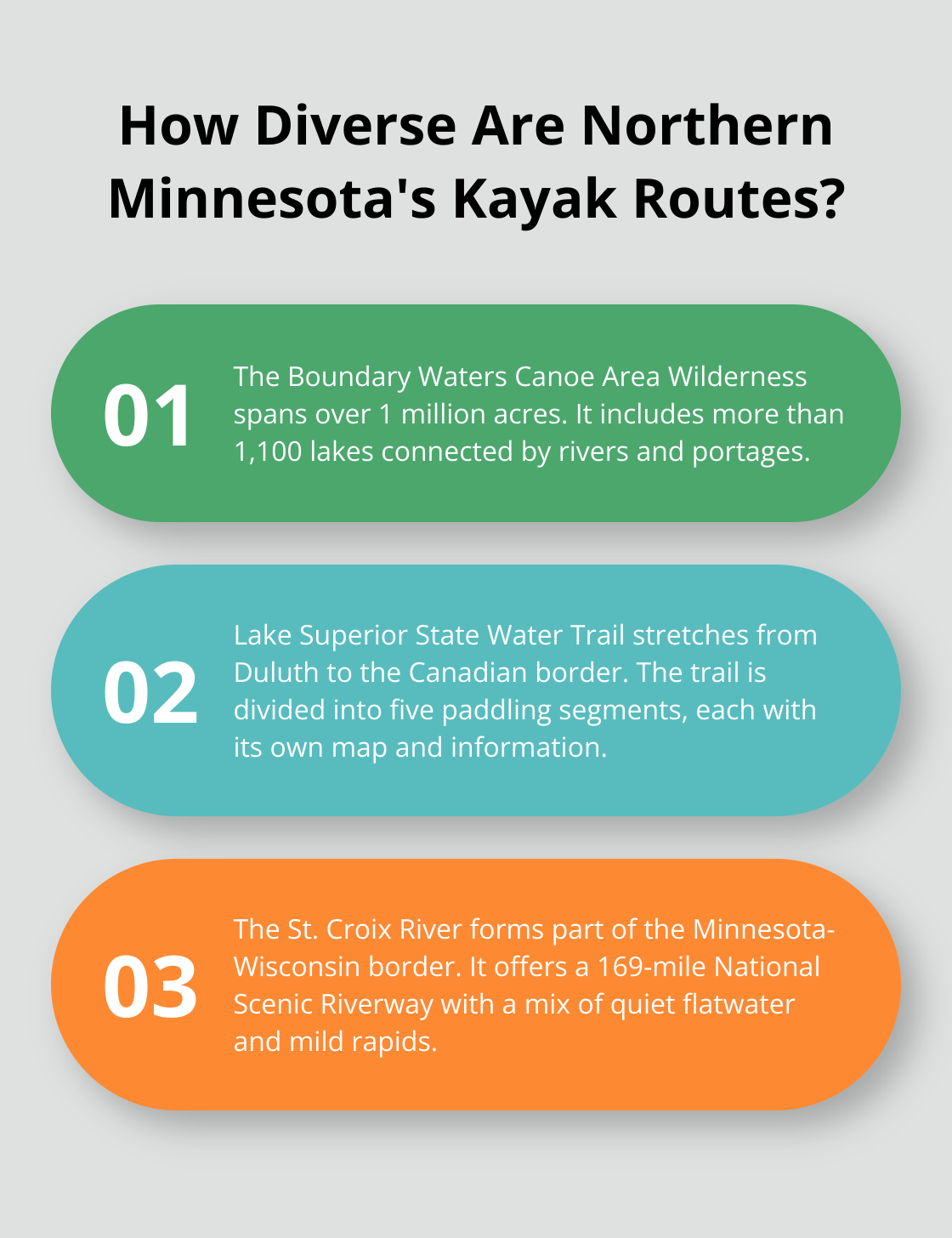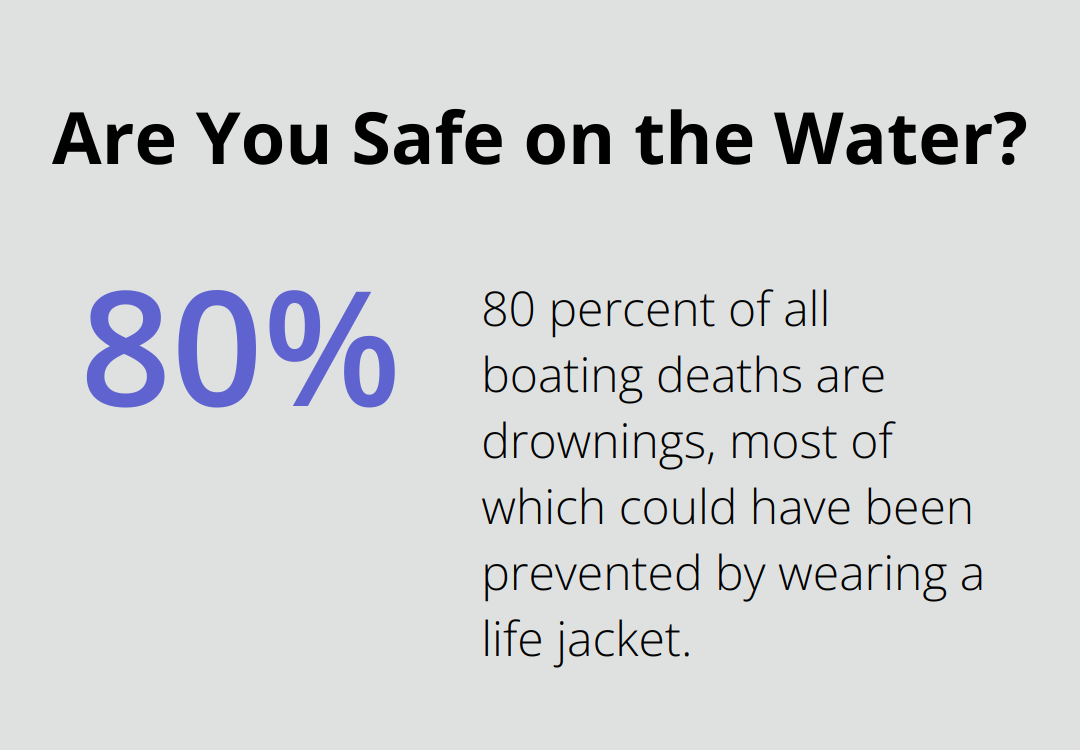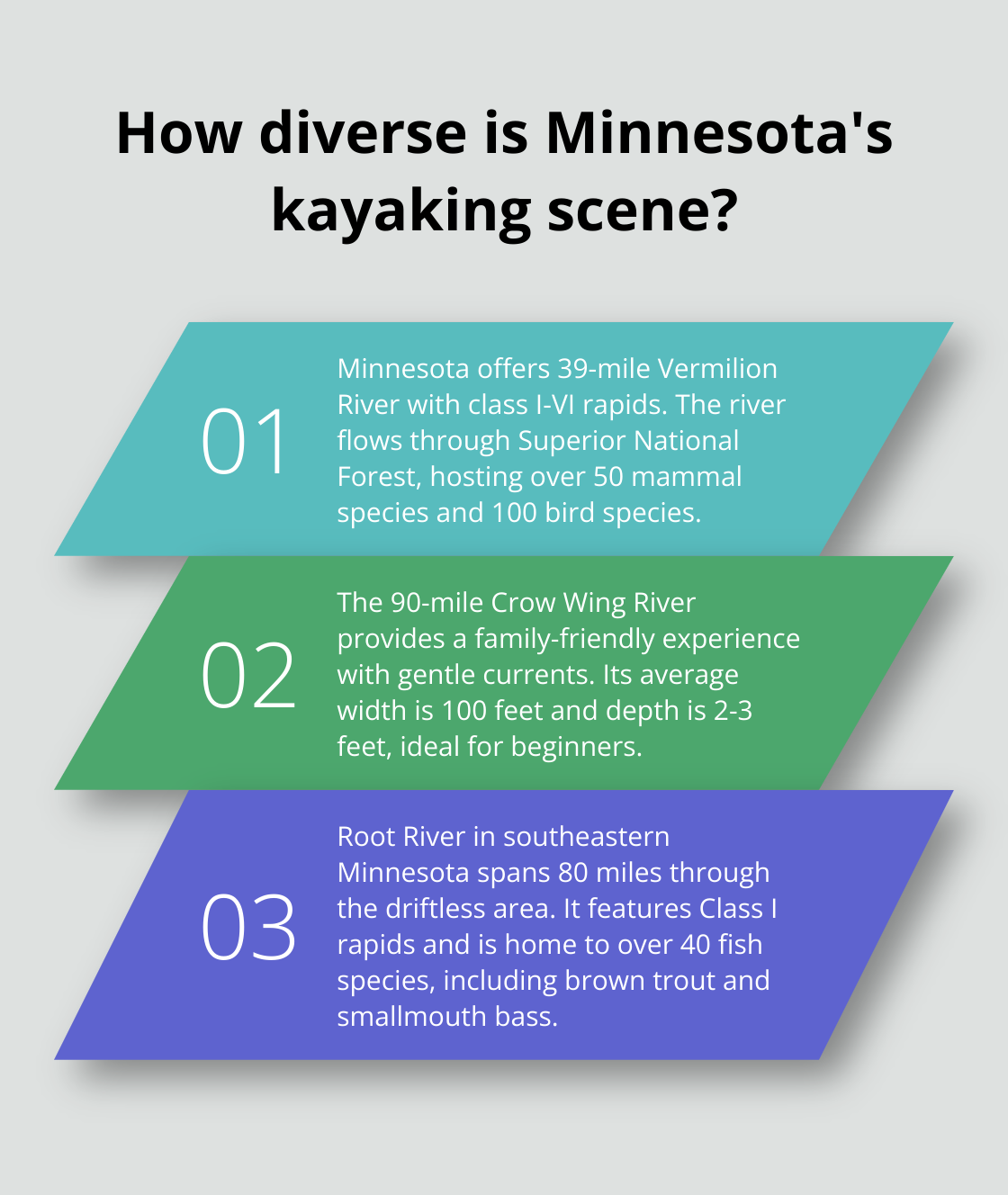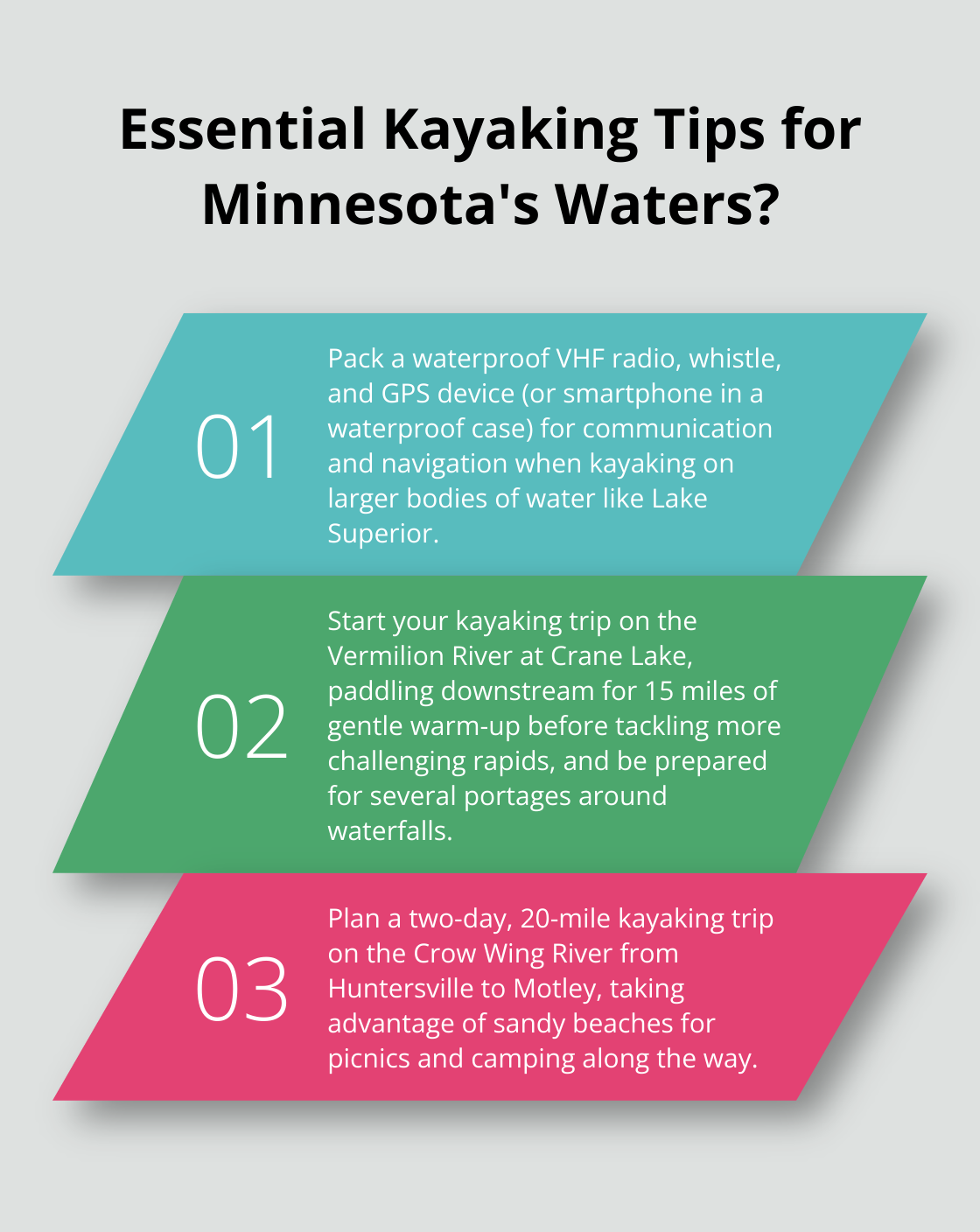Minnesota’s waterways offer a paradise for kayaking enthusiasts. From serene lakes to rushing rivers, the state boasts diverse paddling experiences for every skill level.
At Up North Property Management, we’ve explored countless Minnesota kayak trips and want to share our favorite routes. In this guide, we’ll reveal top destinations, essential safety tips, and hidden gems for unforgettable adventures on the water.
Northern Minnesota’s Top Kayak Routes
Northern Minnesota’s waterways offer some of the most breathtaking kayaking experiences in the United States. We’ve paddled countless miles to bring you the cream of the crop. Here are our top picks for unforgettable kayak adventures in the North Star State.
Boundary Waters Canoe Area Wilderness
The Boundary Waters Canoe Area Wilderness (BWCAW) is a paddler’s paradise. This vast wilderness area spans over 1 million acres and boasts more than 1,100 lakes connected by rivers and portages.

For a truly immersive experience, we suggest a multi-day trip starting from Entry Point 25 at Moose Lake. This route takes you through a chain of scenic lakes, including Knife Lake and Basswood Lake. You’ll encounter pristine forests, rocky cliffs, and abundant wildlife along the way.
Prepare for portages between lakes – some can extend up to a mile long. Pack light and bring a comfortable portage yoke for your kayak. Quota permits are required for overnight trips (paddle, motor, or hiking) and motorized day trips. Obtain the necessary permits well in advance, as they are available by entry point and must be picked up.
Lake Superior State Water Trail
For a mix of rugged shoreline and vast open water, the Lake Superior State Water Trail stands out. This trail follows Minnesota’s North Shore from Duluth to the Canadian border.
A particularly stunning section is the stretch from Split Rock Lighthouse to Tettegouche State Park. This route showcases towering cliffs, hidden coves, and the iconic Split Rock Lighthouse. The water trail is divided into five paddling segments, each with its own map and information available.
Lake Superior’s conditions can change rapidly. Always check the weather forecast and prepare for fog, wind, and waves. A sea kayak with a spray skirt is essential for this route.
St. Croix River
The St. Croix River, forming part of the border between Minnesota and Wisconsin, offers a more relaxed paddling experience. The 169-mile St. Croix National Scenic Riverway provides a perfect blend of gentle currents and scenic beauty.
We recommend the 8-mile stretch from William O’Brien State Park to Osceola Landing. This section features a mix of quiet flatwater and mild rapids, suitable for intermediate paddlers. You’ll glide past towering bluffs, lush forests, and sandy beaches.
For a unique experience, time your trip during the fall when the surrounding maple and oak trees burst into vibrant autumn colors. The river is typically less crowded during this season (September to October), allowing for a more serene paddle.
Each of these routes offers a distinct flavor of Northern Minnesota’s natural beauty. Whether you seek wilderness solitude, dramatic landscapes, or a gentle river float, these kayaking destinations deliver unforgettable experiences on the water. As you plan your next kayaking adventure, consider the essential gear and safety tips that will ensure a smooth and enjoyable journey on Minnesota’s diverse waterways.
Gear Up for Safe Minnesota Kayaking
Essential Equipment
Every kayaker must have a properly fitting personal flotation device (PFD). Every year about 80 percent of all boating deaths are drownings, and most would have been prevented if the victims had been wearing a life jacket. Wear your PFD at all times to avoid becoming a statistic.

A spray skirt is essential for kayaking on larger bodies of water like Lake Superior. It prevents water from entering your kayak in choppy conditions. Pack a waterproof VHF radio and whistle for communication. Use a GPS device or smartphone (in a waterproof case) for navigation.
Dress for immersion, not air temperature. Wear quick-drying, insulating layers and pack extra clothes in a dry bag. A wetsuit or drysuit becomes necessary in colder months to prevent hypothermia.
Weather and Timing
Minnesota’s kayaking season typically runs from May to October. Weather can be unpredictable, so always check the forecast before your trip. Great Lakes nearshore marine forecasts are issued throughout the boating season, typically beginning around April 1 and ending around December 31.
Early mornings often offer the calmest conditions, especially on larger lakes. Wind tends to increase in the afternoon. If you’re new to kayaking, start with shorter trips in protected waters.
Fall offers spectacular foliage views, but prepare for cooler temperatures. Water temperatures can drop quickly, which increases the risk of hypothermia if you capsize.
Safety Protocols
File a float plan with a trusted friend or family member. Include your intended route, expected return time, and emergency contact information. This ensures someone knows where to look if you don’t return as planned.
Practice self-rescue techniques before your trip. Learn how to re-enter your kayak from the water. If paddling with others, practice assisted rescues as well.
Carry a first aid kit and know how to use it. Include any personal medications you might need. A repair kit with duct tape and a multi-tool can help fix minor equipment issues on the go.
Stay alert for other boaters, especially in high-traffic areas. Be visible by wearing bright colors and using a flag or light if necessary. Always follow local boating regulations and respect private property along shorelines.
With these guidelines in mind, you’re ready to explore Minnesota’s hidden kayaking gems. Let’s discover some lesser-known spots that offer unique paddling experiences away from the crowds.
Hidden Kayaking Gems in Minnesota
Minnesota’s waterways hide several lesser-known spots that offer stunning kayaking experiences. These hidden gems provide unique adventures away from the crowds.
Vermilion River: A Whitewater Adventure
The Vermilion River State Water Trail in northeastern Minnesota challenges kayakers with an exhilarating 39-mile stretch. It features scattered class I-VI rapids as it flows through Superior National Forest. Paddlers witness breathtaking views of dense forests and rocky outcrops.

We recommend starting at Crane Lake and paddling downstream. The first 15 miles offer a gentle warm-up before more challenging rapids appear. Prepare for several portages around waterfalls and difficult rapids.
Wildlife spotting adds excitement to the journey. The Minnesota Department of Natural Resources reports that the Vermilion River watershed hosts over 50 mammal species and 100 bird species. Watch for black bears, moose, and bald eagles along the banks.
Crow Wing River: A Family-Friendly Float
The Crow Wing River in central Minnesota provides a relaxed paddling experience. This 90-mile designated water trail flows through Crow Wing State Park, blending scenic beauty with gentle currents.
A great trip starts at Huntersville and ends at Motley, covering about 20 miles in two days. This section features sandy beaches perfect for picnics and camping. Wildlife viewing opportunities abound.
The river’s average width (100 feet) and depth (2-3 feet) make it ideal for families and beginners. The Minnesota Pollution Control Agency has conducted studies on water quality in the area, which can impact the ecosystem of fish and aquatic plants.
Root River: A Scenic Southern Minnesota Gem
In southeastern Minnesota, the Root River winds through the state’s unique driftless area. This 80-mile water trail showcases limestone bluffs, hardwood forests, and charming small towns.
The 30-mile stretch from Lanesboro to Houston makes an excellent two-day trip. It features Class I rapids interspersed with calm pools, suiting intermediate paddlers. The surrounding Root River Trail offers opportunities for biking or hiking to extend your outdoor adventure.
Spring and early summer provide the best water levels for kayaking on the Root River. Over 40 fish species (including brown trout and smallmouth bass) inhabit the river, according to the Minnesota Department of Natural Resources. This diversity makes it popular among anglers as well.
These hidden gems offer unique kayaking experiences for various skill levels. From whitewater thrills to family-friendly floats and scenic paddles, Minnesota’s lesser-known rivers have something for every kayaker. Always check water levels and weather conditions before your trip, and pack essential safety gear.
Final Thoughts
Minnesota kayak trips offer a diverse range of experiences for paddlers of all skill levels. From the rugged wilderness of the Boundary Waters to the scenic beauty of the St. Croix River, the state’s waterways provide endless opportunities for adventure. Safety remains paramount when embarking on any kayaking excursion, so proper planning, essential gear, and awareness of weather conditions are necessary for a successful outing.

At Up North Property Management, we understand the allure of Minnesota’s natural beauty. Our vacation rentals offer the perfect base for your kayaking adventures in Northern Minnesota. After a day on the water, you can return to a fully equipped property to relax and plan your next paddling route.
We encourage you to explore the wonders of Minnesota’s waterways. From serene lakes to rushing rivers, each kayak trip offers a unique perspective on the state’s diverse landscapes. Pack your gear, grab a paddle, and immerse yourself in the natural splendor that makes Minnesota a kayaker’s dream destination.
